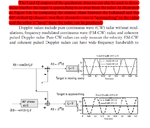aashishsharma
Member level 5
Hey I have just started work with radars. I read that incoming signal in case of Doppler radar is frequency shifted. On adding it to original signal we get doppler shift. But we dont do it directly. First we make I component ( by mixing incoming signal with LO signal) then Q signal by mixing orignal signal with phase shifted LO then do I + jQ. This I understand is to determine the direction of motion either towards or away from Radar. I am attaching excerpt from book. Can anyone please explain how this one signal in each waveform becomes zero?
